AutoCAD Architecture 2010: Key Features
AutoCAD Architecture 2010 has been out for a couple of months. Chances are good that some of you have started using it. Maybe a few of you are still trying to figure out the GUI changes and the new features. In this and the next few articles, let's have a quick look at the new features in AutoCAD Architecture 2010.
Oh boy! Where are my menus?
When you start AutoCAD Architecture 2010 for the first time, the first thing you will notice is that the Menus are no more. AutoCAD Architecture 2010 version is now 100 percent "ribbon oriented." But not to panic, there are ways to bring back the old familiar menus if you want to.
The first thing you can do is to try the 'menubar' command and set the value
to 1.
Command: MENUBAR
Enter new value for MENUBAR <0>: 1
Some of you will see only the "express" menu being loaded. Some will get an error message saying that no menus are defined. One way to solve this is to get into the "Customize User Interface" or CUI dialog and get back the menus from the appropriate "cuix" files. I was able to get all the AutoCAD menus back, but what architecture users will look for are the Design, Document, Format, and CADD Manager menus. I found an interesting link in Autodesk Discussion Forums that will guide you. The following zip file also contains the old classic AutoCAD Architecture or "cuix" files.
The discussion link: Click here
The zip file download link: Click Here
Now while doing so, I renamed a few menus with the suffix "classic" because I found differences between the 2010 menus and the classic ones. The file and format menus are good examples. Also note that I got the 2010 AutoCAD menus from the "acad.cuix" file. As a user of Windows Vista 64-bit, my cuix files were located here:
'C:\Users\Ananthakrishnan\appdata\roaming\autodesk\aca 2010\enu\support\acad.cuix'
You can also load the above cuix file partially. Below is a snapshot comparing the AutoCAD 2010 menus with the old AutoCAD Architecture menus.
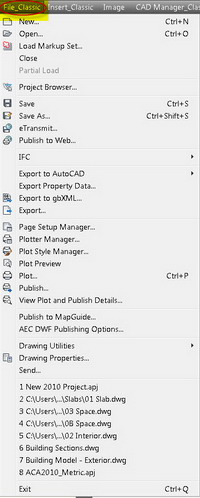
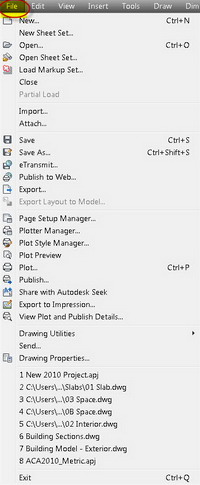
Left: File menu, Classic AutoCAD Architecture
Right: File Menu, AutoCAD 2010
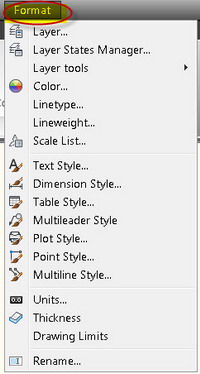
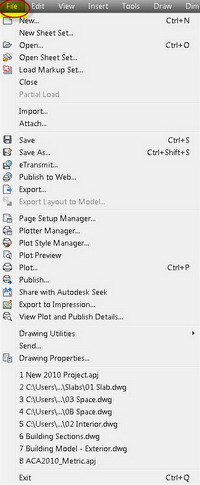
Left: Format menu, AutoCAD 2010
Right: Format Menu, Classic AutoCAD Architecture
By keeping "flavors" of similar menus, I enjoy the best of both worlds. One can also try to create a single custom format menu.
Welcome the new GUI
With a sigh of relief, after getting back the menus, we should not miss the good things that the new GUI provides. Good or bad, let us make the best of it!
The Application Menu

Check out this red colored A icon in the top left corner. Clicking this pulldown reveals a set of basic commands that you use frequently. This menu replaces the Menu Browser, which was found in the earlier version.
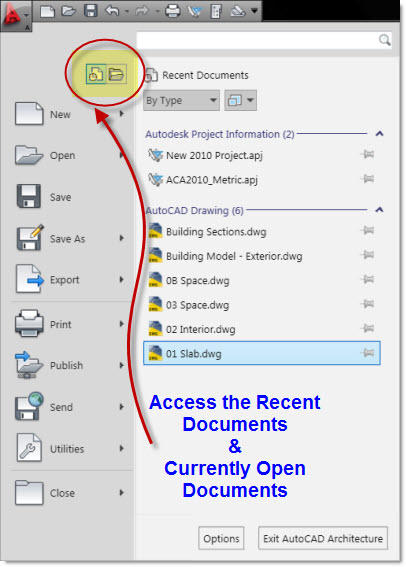
Check out the two buttons I have circled in the image above. These two buttons will help you to see the recently accessed documents and the currently open documents. As the menu's name implies, all the commands available under it are application-oriented and most frequently used, such as new, open, save, export, print, and so on.
Some commands reveal more options as you click the small right arrow next to the command or just hover the mouse over the command. Here is an example of how the export command reveals more options.
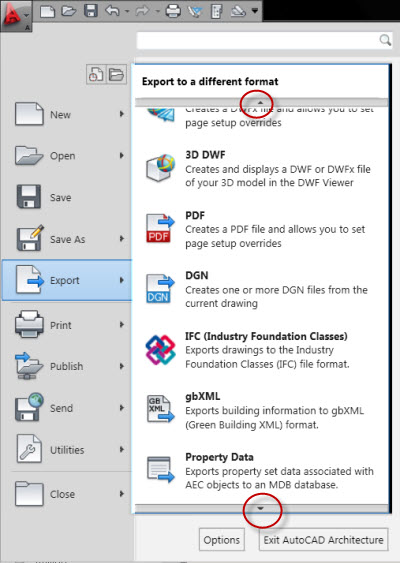
Note the two circled areas in the above image. These two small arrows allow you to scroll through more options.
Do not neglect the search bar and a few other options as shown in the image below.
-
In this Search bar you can perform a real-time search for commands. Search results can include menu commands, basic tooltips, and command prompt text strings. You can enter a search term in any language.
Here is a sample output as I started searching for the string "wall." See the various results.
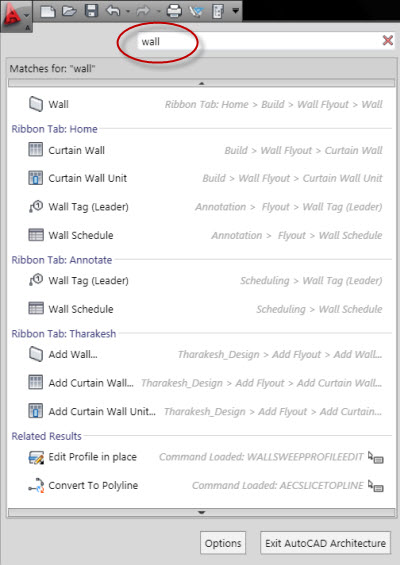
Also, you need not remember the full command or text. As you start typing the first few letters, the search engine goes into action and reveals the closest results.
-
You can arrange the recent document list by type, size, date, and so on using this pulldown.
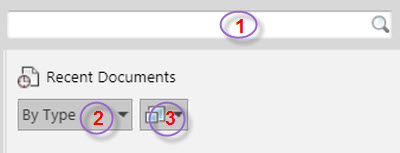
- This pulldown gives you options to decide whether the documents should be listed as an icon or image format. You can also control icon size.
The Ribbon feature, the future

Similarly to the Microsoft Office suite, AutoCAD Architecture 2010 now uses the ribbon as the central access point for commands. The ribbon contains a number of tabs; the tabs, in turn, contains panels on which commands are grouped according to conceptual task types or selected objects. Actually, the ribbon replaces the menu bar and the toolbars as the primary command access point. Even though the ribbon could slow down some new users, I highly suggest you start using the ribbon feature. As you get accustomed to it, you will see great improvement in ease of access.
The most interesting part of the ribbon is that you can completely customize it, create new tabs, panels, and commands that best suit your work needs. In next month's article, we will explore how to customize the ribbon and modify it according to your needs.
If you feel that the ribbon occupies too much screen real estate, you can minimize it to the panel titles, and then click again to minimize to the tabs, if required. You can do this by simply clicking the small arrow button next to the last tab.
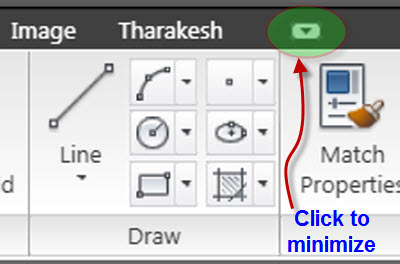
Some quick tips before we close this month's article
-
The 'Ribbonclose' command will close the ribbon.
The 'Ribbon' command will bring back the ribbon.
Note: I suggest not closing the ribbon, but minimizing it instead. -
The '-toolbar' command will allow you to show or hide all the toolbars.
You can also show/hide the toolbars selectively.
See you all next month with more new GUI features and architectural functions.